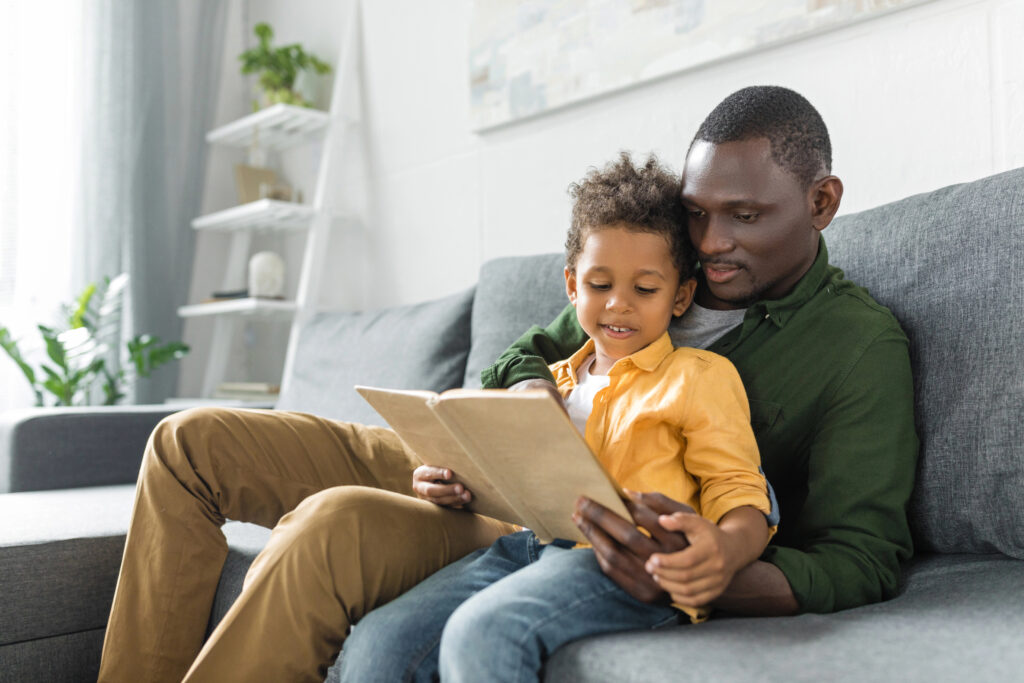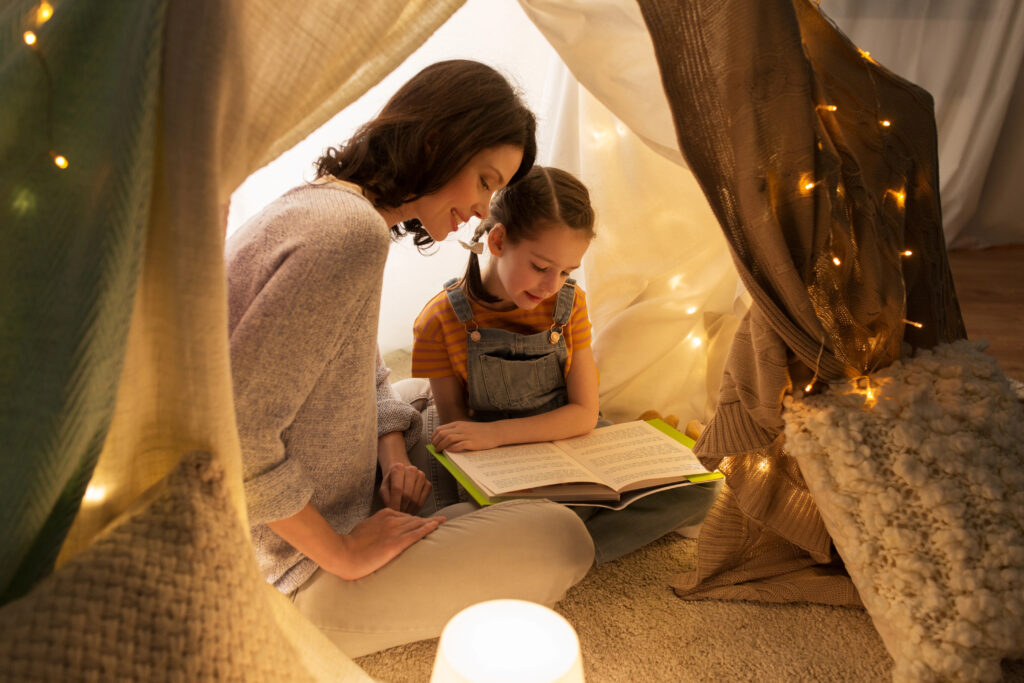
I remember reading Charlie And The Chocolate Factory, by Roald Dahl, to my two oldest kids — maybe they were 5 and 7 at the time. The younger of the two could easily be overwhelmed by empathy, and I could see him straining with the desire to go get a chocolate bar and give it to this child, this fictional character.
To an avid reader like myself, it felt like an utter miracle to share this book and this feeling with my babies. It still does.
The statistics show that parents don’t read to their kids as much these days, and I can understand it — life is busy. However, this particular miracle is one we need to keep sharing.
Why Aren’t Parents Reading To Kids?

Earlier this year, The Guardian reported on a Nielsen survey in which only 40% of parents said that reading to their kids was an enjoyable activity.
A similar percentage of children aged four or under are being read to regularly, with girls being read to more frequently than boys. There’s a generation gap here, too — “Gen Z parents are more likely than millennial or Gen X parents” to consider reading a chore or subject than a fun activity for kids.
Parents who think of reading as a skill to master are also more likely to stop reading to their kids once the kids can read for themselves.
Still, about a third of parents say they wish they had more time to read to their kids, and 44% say that reading together makes them feel closer to their kids.
The Experiences That Make Reading Together Magical
I still read to my kids regularly. Not quite as regularly during the summer as during the school year, and never quite as consistently as I’d like, but I still aim for at least 20 minutes several times a week for the older ones (9, 11, and 13) and multiple books daily for the 5-year-old.
Sometimes my 19-year-old will join us, and once recently, my 23-year-old was visiting and even sat in!
That was when we were reading Bruce Coville’s My Teacher Is An Alien series.
We had just finished the first three Wayside School books, by Louis Sachar, and I wanted to switch from short stories to a novel, and introduce another series I loved as a kid myself. I was so anxious about them enjoying it, and for the first couple of chapters, my kids weren’t very interested — then all of a sudden it clicked, and we found that magic space where they ask for “one more chapter” when I think we’re done for the night!
Then, after we’d closed the book for the night, my oldest said, “I remember this story from when you read it to us [the two oldest kids],” and with that simple statement comes a moment of knowing that something made an impact. I didn’t read to my oldest kids as much as I wish I had, but my child unknowingly just told me that the times I did read to them made an impact! It mattered!
Finding The Book Balance

Reading kids’ books can be like playing Candyland — you remember enjoying it when you were little, but now maybe it feels trite and saccharine.
It doesn’t have to, though!
There is a near-infinite variety of books for little kids, whether you want to make them laugh by reading about canine flatulence (Walter the Farting Dog, by William Kotzwinkle), or introduce them to philosophical thinking (Big Ideas for Young Thinkers, by Jamia Wilson).
If you absolutely can’t stand reading another book about talking dogs and hardworking anthropomorphic trains, maybe try diving into classics like Ellen Raskin’s The Westing Game and The Phantom Tollbooth by Norton Juster.
(Okay, The Phantom Tollbooth does have a talking dog, but if you like wordplay, you’ll love it. My younger son, 8 at the time, and not a huge fan of reading, actually took it out of my hands and demanded a turn reading aloud.)
Even for younger kids, some books are engaging enough that parents can love them too.
When The Gruffalo, by Julia Donaldson, arrived in our mailbox (thank you, Dolly Parton’s Imagination Library), my husband and I, along with all the big kids (probably 10, 13, and 15 at the time), took turns reading it to the little boys. We immediately had to get a copy of the sequel, because honestly, the book is just so much fun.
Even if you dislike every book I’ve listed above, there is something out there that your kids will enjoy, and that meets your interests, too!
Choosing Higher-Level Books Is Always An Option
One great thing about reading to kids is that you can choose books above their reading level, as long as the subject matter is appropriate.
When I was little, I’d beg my mom to read aloud when she read from her Bible at night. I certainly didn’t understand much of it at the time, but being read to still feels cozy and loving.
I’ve noticed the same with my kids. Even when I’m reading a book targeted at older readers, the kids who are too young for that particular book will still cuddle in to listen.
Reading on a kid’s level is important and good for them, but if you genuinely can’t tolerate another read of Goodnight Moon, by Margaret Wise Brown, reading to your kid from William Golding’s The Princess Bride, or Lucy Maude Montgomery’s Anne of Green Gables series, or A Wrinkle In Time, by Madeleine L’Engle, is also wonderful.
You Don’t Have To Spend A Ton Of Time

The target, according to the Children’s Reading Foundation, is 20 minutes a day.
However, if you aren’t hitting that target, don’t consider it a failure. Reading to your kids the amount you are able is better than skipping it altogether.
As I mentioned earlier, the current target in my household is 20 minutes at a time, at least 3 times a week, for my older kids. My 5-year-old is learning to read for herself right now (and I cannot laud Hooked On Phonics enough; the app is fantastic and the books they send are perfect) so we read together much more frequently.
Still, even if all you can squeeze in is 20 minutes at a time on weekends, that’s great too. (One of Barbara Park’s Junie B. Jones’ books can typically be finished in two 20-minute sessions.)
The important part is that you are making reading time into a fun and bonding experience.
Why Is It So Important?
Reading to your kids is incredibly valuable in many ways.
I’ve raved about the connection, the joy when you and your child are both on the edge of your seat waiting to hear whether this bar of chocolate is the one with the golden ticket, or rooting for three kids to help their alien teachers save planet Earth successfully. That is an indescribable bonding sensation.
However, there is also tangible evidence that reading to your children improves their language skills and sets them up for academic success. A study from the University of Ohio concluded:
“Young children whose parents read them five books a day enter kindergarten having heard about 1.4 million more words than kids who were never read to…Even kids who are read only one book a day will hear about 290,000 more words by age 5 than those who don’t regularly read books with a parent or caregiver.”
Experts say this prepares kids to encounter those and other words in print and build bigger and more adaptive vocabularies.
These kids are also more likely to pick up reading for fun, which has further benefits. Forbes reported in 2023 on a study comparing kids who read for fun to those who do not.
“Children who start to read for fun early in life get better test scores by the time they reach adolescence…Reading for pleasure by the age of nine is also linked to better mental health, less screen time and better sleep, compared to children who start later or not at all, researchers found.”
All of this is a gift we can give our kids, just by finding the time to read to them regularly!

